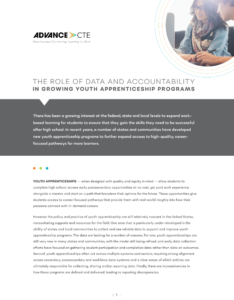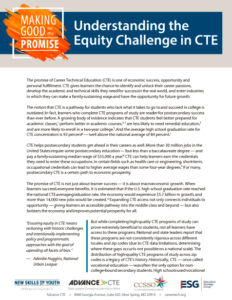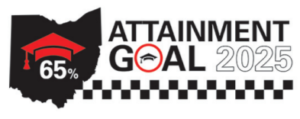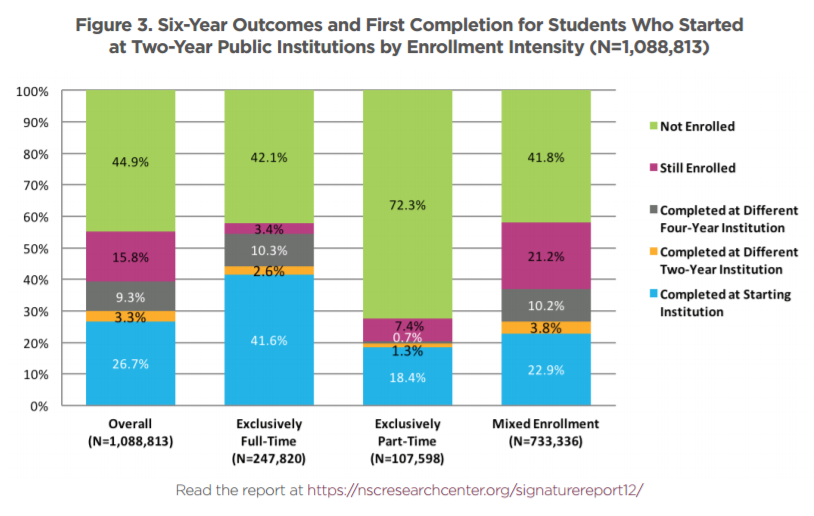Over the past six mon ths, Advance CTE and the Institute of Education Sciences (IES) have worked together to highlight the power of Career Technical Education (CTE) research partnerships in improving quality and equity in CTE. In Michigan, years of close collaboration between the Department of Education and the University of Michigan has enabled state leaders to address critical policy questions like choosing a secondary CTE program quality performance indicator. South Dakota leveraged relationships in the research community to improve data quality and foster a data-driven culture at the state level. And in Massachusetts, state leaders are working alongside long-time research partners to identify critical access and opportunity gaps and build solutions that enable equitable access to high-quality CTE.
ths, Advance CTE and the Institute of Education Sciences (IES) have worked together to highlight the power of Career Technical Education (CTE) research partnerships in improving quality and equity in CTE. In Michigan, years of close collaboration between the Department of Education and the University of Michigan has enabled state leaders to address critical policy questions like choosing a secondary CTE program quality performance indicator. South Dakota leveraged relationships in the research community to improve data quality and foster a data-driven culture at the state level. And in Massachusetts, state leaders are working alongside long-time research partners to identify critical access and opportunity gaps and build solutions that enable equitable access to high-quality CTE.
Partnerships like these provide measurable benefits by allowing state policymakers to make informed decisions that impact learner success and bolster state talent pipelines – but they do come at a cost. The partnerships highlighted in this series were supported via a combination of state, federal and foundation funds. Research grant funds are most often used to cover personnel time for work on the research project, both at the university or research organization and at the partner education agency. As many of the state agency interviewees mentioned, it is difficult to carve time out of their regular responsibilities to work on a research project. By securing dedicated funding to cover part or all of a person’s salary, a state agency can afford to spend time on a research project. In addition, research grant funds can be used to provide incentives for students, teachers and schools to participate in a research study, for the development and administration of surveys or classroom observation tools (to complement information available in administrative data systems), and for software and hardware to analyze and house the data.
With growing public support for CTE, fueled by urgent needs for skilled labor, CTE programs will be called upon to do even more. States should be prepared with a research and evaluation strategy to determine whether and which strategies are most effective (and cost-effective). So how should states go about establishing and funding new CTE research partnerships?
Options for Financing State CTE Research Partnerships
There are a number of avenues states can take to finance CTE research. Federal sources of funding for CTE-related research include the Department of Education, the Department of Labor and the National Science Foundation. Education research funding may also be available at other agencies, such as the Department of Agriculture. Private funding for CTE research projects is also available from foundations such as the ECMC Foundation[i], the Smith Richardson Foundation, and the Laura and John Arnold Foundation.
The National Center for Education Research (NCER) at IES launched a special CTE topic in its Education Research Grants program in 2017 to encourage researchers to study CTE. Funded grants under this topic have examined CTE-related issues such as industry certifications, applied-STEM (Science, Technology, Engineering and Mathematics) CTE pathways and work-based learning. IES also funds CTE research under other programs and maintains a CTE Statistics webpage. In 2018, in partnership with the Office of Career, Technical, and Adult Education (OCTAE), IES formed a CTE Research Network to increase the amount and quality of causal research in CTE. CTE Research Network members have been studying the impact of various CTE programs and delivery models on student high school, postsecondary and labor market outcomes. The National Center for Special Education Research (NCSER) began funding CTE research for students with disabilities in 2019.
New Opportunity to Apply for Federal Funding to Study CTE!
 There is good news for state leaders and researchers interested in initiating CTE research partnerships. NCER has just released its Fiscal Year 2021 Request for Applications (RFA) for its Education Research Grants Program (CFDA 84.305A). This grants program, one of several in NCER, was established in 2002 to produce research that is scientifically rigorous and relevant to the needs of education practitioners and decisionmakers. NCER welcomes CTE-related research proposals under the CTE topic or under other topics (such as STEM, Improving Education Systems, and Postsecondary and Adult Education). NCSER has a separate RFA for its special education research grants program (CFDA 84.324A) and welcomes applications to study CTE for students with disabilities.
There is good news for state leaders and researchers interested in initiating CTE research partnerships. NCER has just released its Fiscal Year 2021 Request for Applications (RFA) for its Education Research Grants Program (CFDA 84.305A). This grants program, one of several in NCER, was established in 2002 to produce research that is scientifically rigorous and relevant to the needs of education practitioners and decisionmakers. NCER welcomes CTE-related research proposals under the CTE topic or under other topics (such as STEM, Improving Education Systems, and Postsecondary and Adult Education). NCSER has a separate RFA for its special education research grants program (CFDA 84.324A) and welcomes applications to study CTE for students with disabilities.
Research grant applications are due at midnight (Eastern time) on August 20, 2020. Letters of intent (not required but encouraged) are due on June 11, 2020. Each of the open RFAs, as well as archived webinars for applicants about the IES grant process, are available on the IES funding opportunities page.
Applicants should start early to make sure they have everything they need. In addition to viewing on-demand webinars, applicants should be sure to read the RFA closely and pay attention not only to the application requirements but also to the IES recommendations for a strong application. For example, applicants should describe their theory of change and any prior research on the issue; align their research methods to the research questions; describe measures and data source; and make sure the sample size offers adequate statistical power. This grants program is very competitive, and peer reviewers will be paying attention to whether applicants follow the recommendations. Everyone involved in the submission process should also familiarize themselves with the IES submission guide, which details the steps necessary to successfully submit an application online.
We are eager to hear any and all ideas! Corinne Alfeld (Corinne.alfeld@ed.gov) and Austin Estes (aestes@careertech.org) would be happy to discuss them, and Corinne can also provide technical assistance in writing research grant application to IES. She can be reached by email to set up a phone call to discuss project ideas.
This final blog post wraps up our series aimed at increasing state CTE research partnerships by highlighting ways to seek research funding. Corinne Alfeld, Research Analyst at IES and Austin Estes, Manager of Data & Research at Advance CTE, collaborated to create this blog series in the hopes that more state agencies would partner with researchers to examine research questions related to CTE using state data.
[i] The ECMC Foundation is a funder of Advance CTE’s work.



 Cliff – I would say that the particular catalyst for our most recent partnership is our desire as an agency to understand the waitlist demand issues related to
Cliff – I would say that the particular catalyst for our most recent partnership is our desire as an agency to understand the waitlist demand issues related to  Marc – When we were doing needs sensing with the states in our region, particularly with South Dakota, CTE emerged as a pretty high priority area. We needed to determine what the research questions were, what questions we could actually address, and what data were available that could be used in those research projects. So, this work started off as a technical assistance project where we were working with South Dakota pretty closely and getting all of the relevant players around a table and going through and mapping their data. And it was quite a long process.
Marc – When we were doing needs sensing with the states in our region, particularly with South Dakota, CTE emerged as a pretty high priority area. We needed to determine what the research questions were, what questions we could actually address, and what data were available that could be used in those research projects. So, this work started off as a technical assistance project where we were working with South Dakota pretty closely and getting all of the relevant players around a table and going through and mapping their data. And it was quite a long process.


 Through NSFY, Delaware, Kentucky, Louisiana, Massachusetts, Nevada, Ohio, Oklahoma, Rhode Island, Tennessee and Wisconsin took action to:
Through NSFY, Delaware, Kentucky, Louisiana, Massachusetts, Nevada, Ohio, Oklahoma, Rhode Island, Tennessee and Wisconsin took action to: Youth apprenticeship programs can give students access to valuable work-based learning experiences that provide insights into how their interest can connect to education and the workforce. Although these programs are often beneficial for participants, there is little data to show the programmatic landscape and impact. A lack of data inhibits the development and expansion of youth apprenticeship programs.
Youth apprenticeship programs can give students access to valuable work-based learning experiences that provide insights into how their interest can connect to education and the workforce. Although these programs are often beneficial for participants, there is little data to show the programmatic landscape and impact. A lack of data inhibits the development and expansion of youth apprenticeship programs.  Throughout history, and continuing today, learners of color, low-income learners, female learners and learners with disabilities have been historically tracked into terminal vocational programs leading to jobs with uncertain promise of economic growth and prosperity. While the quality of CTE programs has significantly improved since then, many of these same learners cannot access high-quality CTE programs of study that prepare them for success in postsecondary education and their future careers.
Throughout history, and continuing today, learners of color, low-income learners, female learners and learners with disabilities have been historically tracked into terminal vocational programs leading to jobs with uncertain promise of economic growth and prosperity. While the quality of CTE programs has significantly improved since then, many of these same learners cannot access high-quality CTE programs of study that prepare them for success in postsecondary education and their future careers. The
The  Similarly, in Ohio, three community colleges
Similarly, in Ohio, three community colleges Nearly two years of planning came to a head on Monday as states hit the second plan submission window under the Every Student Succeeds Act (ESSA). Under the law, states are required to engage in stakeholder consultation and develop a comprehensive, statewide strategy for spending and holding districts and schools accountable for billions of dollars in K-12 federal education funding.
Nearly two years of planning came to a head on Monday as states hit the second plan submission window under the Every Student Succeeds Act (ESSA). Under the law, states are required to engage in stakeholder consultation and develop a comprehensive, statewide strategy for spending and holding districts and schools accountable for billions of dollars in K-12 federal education funding. 